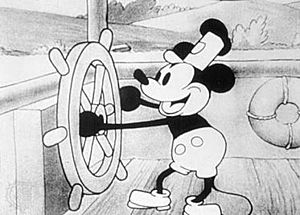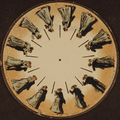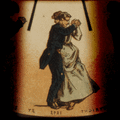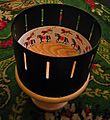Animated cartoon facts for kids
An animated cartoon is a short movie where drawings or computer images are made to look like they are moving. These fun films often tell a story. You can watch them in movie theaters, on TV, or on computer screens.

Contents
How Did Cartoons Begin?
Long, long ago, even paleolithic cave painters tried to show movement in their art. They drew animals with many legs in different positions. This made it look like the animals were running or moving.
Later, people invented clever devices to make pictures move. The phenakistoscope (made in 1832) and the zoetrope (from 1834) were early examples. The praxinoscope (1877) and the simple flip book also created movement. These devices used a series of drawings shown quickly to trick your eyes into seeing motion. However, animation really took off when motion picture film was invented.
-
An 1893 phenakistoscope disc by Eadweard Muybridge.
-
An 1886 Flip book
How Are Animated Cartoons Made?

The invention of film made it possible to create amazing animated art. The basic way animation works is explained in the article Animation. The classic way of making cartoons, by hand-drawing each picture, is called Traditional animation.
From Silent to Sound Cartoons
At first, animated cartoons were black-and-white and had no sound. A famous example is Felix the Cat.
The first cartoon with synchronized sound is often thought to be Walt Disney's Steamboat Willie from 1928. This cartoon starred Mickey Mouse. However, Max Fleischer's 1926 film, My Old Kentucky Home, actually had synchronized sound earlier. Fleischer also invented rotoscoping. This was a cool trick where animators could trace over live action film to make animation look more realistic.
When sound came along, music became a big part of cartoons. Characters often repeated actions in "loops," meaning drawings were shown over and over. These actions were timed perfectly with the music. Sometimes, new music was made, and sometimes, famous tunes were used.
Adding Color and Special Effects
Disney also made the first full-color cartoon using Technicolor. It was called "Flowers and Trees" and came out in 1931. Other filmmakers had tried color before, but Technicolor's 3-color process made the colors much better.
Over time, other movie technologies were used in animation. These included multiplane cameras, which gave a feeling of depth. Stereophonic sound was used in Disney's Fantasia in 1941, making the music sound even more amazing. Later, cartoons also used wide screens (like CinemaScope) and even 3D effects.
Modern Computer Animation
Today, many cartoons are made using computers. Computers give animators many new tools that were not available with hand-drawn animation. You can learn more about this in Computer animation.
However, not all animation is called a "cartoon." The word "cartoon" usually means something that looks like drawings. Most 3D computer animation, as well as clay animation and other types of stop motion filming, are usually not called cartoons.
An animated cartoon made using Adobe Flash is sometimes called a webtoon.
See Also





